Themed collection Most popular 2022 supramolecular chemistry articles

Porous liquids – the future is looking emptier
The realisation of permanent microporosity in liquids transforms the way functional porosity may be implemented. Considering recent advances, we explore the developing theory of porous liquids and delve into the discovery process and applications.
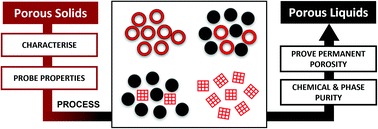
Chem. Sci., 2022,13, 5042-5054
https://doi.org/10.1039/D2SC00087C
Mechanically interlocked molecular handcuffs
Mechanically interlocked molecules that employ a handcuff component provide a pathway to highly unusual structures, a new nomenclature is proposed which helps to identify opportunities for employing this structural unit for new architectures.
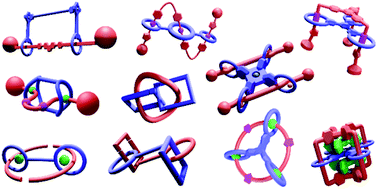
Chem. Sci., 2022,13, 3915-3941
https://doi.org/10.1039/D2SC00568A
Distinctive features and challenges in catenane chemistry
Catenane chemistry is closely associated with that of rotaxane and knot, and this perspective highlights their similarities and differences in various aspects including synthesis, structure and properties.
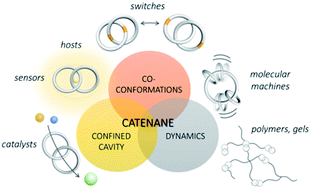
Chem. Sci., 2022,13, 3315-3334
https://doi.org/10.1039/D1SC05391D
Bottom-up supramolecular assembly in two dimensions
The self-assembly of molecules in two dimensions (2D) is gathering attention from all disciplines across the chemical sciences. This perspective discusses the main strategies to direct the supramolecular self-assembly of organic monomers in 2D.

Chem. Sci., 2022,13, 3057-3068
https://doi.org/10.1039/D1SC05667K
Supramolecular assembly confined purely organic room temperature phosphorescence and its biological imaging
Purely organic room temperature phosphorescence, especially in aqueous solution, is attracting increasing attention owing to its large Stokes shift, long lifetime, low preparation cost, low toxicity, good processing performance advantages, and broad application value.
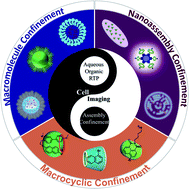
Chem. Sci., 2022,13, 7976-7989
https://doi.org/10.1039/D2SC01770A
A light-gated regulation of the reaction site by a cucurbit[7]uril macrocycle
On–off competitive inhibition is presented. Photoswitchable pseudorotaxane controls the rate of self-reaction and product selectivity of external reactions.
![Graphical abstract: A light-gated regulation of the reaction site by a cucurbit[7]uril macrocycle](/en/Image/Get?imageInfo.ImageType=GA&imageInfo.ImageIdentifier.ManuscriptID=D2SC02077G&imageInfo.ImageIdentifier.Year=2022)
Chem. Sci., 2022,13, 12440-12444
https://doi.org/10.1039/D2SC02077G
Orientational self-sorting in cuboctahedral Pd cages
Cuboctahedral [Pd12L24]24+ cages based on low-symmetry ligands can potentially form a vast number of isomers, but the self-assembly process was found to be highly selective.

Chem. Sci., 2022,13, 11912-11917
https://doi.org/10.1039/D2SC03856K
Stereomutation and chiroptical bias in the kinetically controlled supramolecular polymerization of cyano-luminogens
The emissive features of supramolecular polymers formed by cyano-luminogens depends on the nature of the central aromatic unit. Intramolecular H-bonded species influence the chiroptical properties and the resulting aggregated species can be kinetically controlled.

Chem. Sci., 2022,13, 11577-11584
https://doi.org/10.1039/D2SC03449B
A chemically fueled supramolecular glue for self-healing gels
Chemically fueled supramolecular materials offer unique properties like the ability to self-heal, yet, mechanisms remain elusive. Here, we demonstrate that chemically fueled gels heal because of a molecular glue-based mechanism.

Chem. Sci., 2022,13, 11411-11421
https://doi.org/10.1039/D2SC03691F
Reconstructing reactivity in dynamic host–guest systems at atomistic resolution: amide hydrolysis under confinement in the cavity of a coordination cage
Encapsulation of guests in metal–organic cages allows control over chemical reactivity. Focusing on the hydrolysis of amides, here we show an effective molecular simulation approach to reconstruct reactivity in host–guest systems in dynamic regimes.
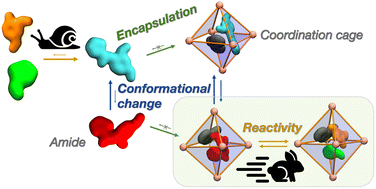
Chem. Sci., 2022,13, 11232-11245
https://doi.org/10.1039/D2SC02000A
Establishing the selective phospholipid membrane coordination, permeation and lysis properties for a series of ‘druggable’ supramolecular self-associating antimicrobial amphiphiles
A combination of computational and synthetic phospholipid vesicle/nanodisc assays are used to investigate the mode of action for a class of antimicrobial agents, while a range of DMPK studies establish agent druggability.
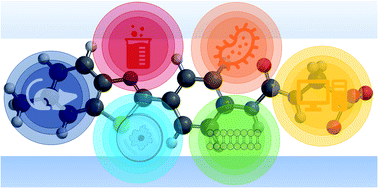
Chem. Sci., 2022,13, 9761-9773
https://doi.org/10.1039/D2SC02630A
The rippled β-sheet layer configuration—a novel supramolecular architecture based on predictions by Pauling and Corey
The rippled sheet was proposed by Pauling and Corey in 1953, yet structural foundation remains extremely limited. Here we report on three X-ray crystal structures of rippled β-sheets, thus providing the long-sought structural basis for the field.

Chem. Sci., 2022,13, 8947-8952
https://doi.org/10.1039/D2SC02531K
Caged bulky organic dyes in a polyaromatic framework and their spectroscopic peculiarities
Here we report that the open large cavity of an M2L4 polyaromatic cage can efficiently bind sterically demanding organic dyes with coumarin, perylene bisimide, and porphyrin cores in aqueous solution. The spectroscopic properties of the caged dyes are largely modulated in the cavity.
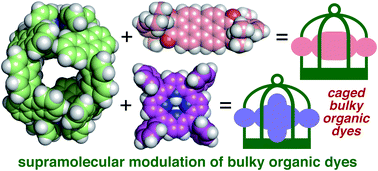
Chem. Sci., 2022,13, 8642-8648
https://doi.org/10.1039/D2SC02308C
Hierarchical supramolecular co-assembly formation employing multi-component light-harvesting charge transfer interactions giving rise to long-wavelength emitting luminescent microspheres
Green luminescent microspheres, generated via charge-transfer interaction-induced hierarchical co-assembly of a bis-naphthyl dipicolinic amide derivative and tetracyanobenzene, transfer energy to long-wave emitting dye.
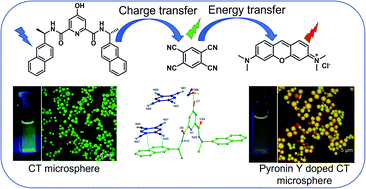
Chem. Sci., 2022,13, 7805-7813
https://doi.org/10.1039/D2SC02097A
A host–guest strategy for converting the photodynamic agents from a singlet oxygen generator to a superoxide radical generator
A supramolecular strategy is reported for converting the conventional photodynamic agents from a singlet oxygen generator to a superoxide radical generator by the host–guest interaction enhanced electron transfer.
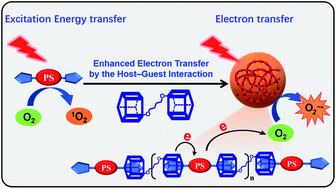
Chem. Sci., 2022,13, 5951-5956
https://doi.org/10.1039/D2SC01469F
CPL on/off control of an assembled system by water soluble macrocyclic chiral sources with planar chirality
Readily obtained pillar[5]arenes with pure planar chirality enabled CPL on/off control of an assembled system by varying the feed ratio.

Chem. Sci., 2022,13, 5846-5853
https://doi.org/10.1039/D2SC00952H
Metastable doubly threaded [3]rotaxanes with a large macrocycle
Multiple metastable doubly threaded [3]rotaxanes using a large 46 atom ring were prepared and fully characterized. Varying the stopper group size gave a range of interlocked stabilities in CDCl3 from a half-life of <1 minute to ca. 6 months.
![Graphical abstract: Metastable doubly threaded [3]rotaxanes with a large macrocycle](/en/Image/Get?imageInfo.ImageType=GA&imageInfo.ImageIdentifier.ManuscriptID=D2SC01486F&imageInfo.ImageIdentifier.Year=2022)
Chem. Sci., 2022,13, 5333-5344
https://doi.org/10.1039/D2SC01486F
Highly selective synthesis and near-infrared photothermal conversion of metalla-Borromean ring and [2]catenane assemblies
The selective synthesis of three kinds of supermolecular topologies, molecular Borromean ring, [2]catenane and metallarectangle based on two alkynyl ligands is presented. Remarkably, the NIR photothermal conversion efficiency was found to improve as the π–π stacking increases.
![Graphical abstract: Highly selective synthesis and near-infrared photothermal conversion of metalla-Borromean ring and [2]catenane assemblies](/en/Image/Get?imageInfo.ImageType=GA&imageInfo.ImageIdentifier.ManuscriptID=D2SC00437B&imageInfo.ImageIdentifier.Year=2022)
Chem. Sci., 2022,13, 5130-5140
https://doi.org/10.1039/D2SC00437B
Fuel-driven macromolecular coacervation in complex coacervate core micelles
We apply an allyl acetate fuelled chemical reaction network (CRN) to control the coacervation of macromolecular species at constant physiological pH without the need for complex biomolecules.

Chem. Sci., 2022,13, 4533-4544
https://doi.org/10.1039/D2SC00805J
Recognition competes with hydration in anion-triggered monolayer formation of cyanostar supra-amphiphiles at aqueous interfaces
The selective binding of anions transform macrocycles into amphiphiles that form monolayers on the surface of water depending upon the relative roles of anion hydration and anion recognition.
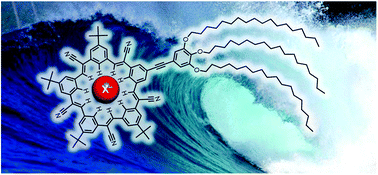
Chem. Sci., 2022,13, 4283-4294
https://doi.org/10.1039/D2SC00986B
Chiral molecular nanosilicas
A molecular folding strategy is developed to construct ferrocenyl diamino acid conjugated polyhedral oligosiloxane molecules. Hydrogen bonding-driven folding facilitates the chirality transfer from the molecular scale to the micrometer scale.

Chem. Sci., 2022,13, 4029-4040
https://doi.org/10.1039/D2SC00793B
Controlling the lifetime of cucurbit[8]uril based self-abolishing nanozymes
Self-inhibitory feedback regulated transient assembly of a CB[8] based nanozyme is reported whose lifetime can be manipulated in multiple ways, ranging from minutes to hours.
![Graphical abstract: Controlling the lifetime of cucurbit[8]uril based self-abolishing nanozymes](/en/Image/Get?imageInfo.ImageType=GA&imageInfo.ImageIdentifier.ManuscriptID=D1SC07203J&imageInfo.ImageIdentifier.Year=2022)
Chem. Sci., 2022,13, 4050-4057
https://doi.org/10.1039/D1SC07203J
Sterically demanding macrocyclic Eu(III) complexes for selective recognition of phosphate and real-time monitoring of enzymatically generated adenosine monophosphate
We present two new europium-based anion receptors that selectively bind to inorganic phosphate and AMP in aqueous media. Their sensing selectivity follows the order AMP > ADP > ATP, representing a reversal of the selectivity order observed for most nucleoside phosphate receptors.
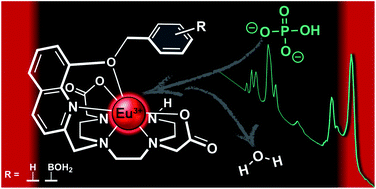
Chem. Sci., 2022,13, 3386-3394
https://doi.org/10.1039/D1SC05377A
Helicity-driven chiral self-sorting supramolecular polymerization with Ag+: right- and left-helical aggregates
Chiral self-sorting supramolecular polymerization of bola-type terpyridine-based ligands (R-L1 and S-L1) comprising R- or S-alanine analogs occurred upon addition of Ag+ in one enantiomeric component.
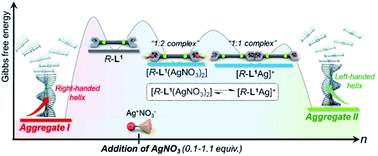
Chem. Sci., 2022,13, 3109-3117
https://doi.org/10.1039/D1SC06413D
A carbonyl-rich covalent organic framework as a high-performance cathode material for aqueous rechargeable zinc-ion batteries
A covalent organic framework (Tp-PTO-COF) with carbonyl active sites was proposed as a novel cathode material and successfully applied in aqueous rechargeable zinc-ion batteries (ZIBs).

Chem. Sci., 2022,13, 2385-2390
https://doi.org/10.1039/D1SC06412F
Arene–perfluoroarene interactions confer enhanced mechanical properties to synthetic nanotubes
Arene–perfluoroarene interactions resulted in enhanced crystallinity between analogous perhydro- and perfluoro macrocycles in a supramolecular nanotube assembly.

Chem. Sci., 2022,13, 2475-2480
https://doi.org/10.1039/D1SC05932G
Size-dependent compression of threaded alkyldiphosphate in head to head cyclodextrin [3]pseudorotaxanes
Alkyl chain compression of alkanediphosphate guests was achieved by head-to-head cyclodextrin [3]pseudorotaxanes in a mechanostereoselective self-assembly process.
![Graphical abstract: Size-dependent compression of threaded alkyldiphosphate in head to head cyclodextrin [3]pseudorotaxanes](/en/Image/Get?imageInfo.ImageType=GA&imageInfo.ImageIdentifier.ManuscriptID=D1SC05697B&imageInfo.ImageIdentifier.Year=2022)
Chem. Sci., 2022,13, 2218-2225
https://doi.org/10.1039/D1SC05697B
Synthesis, aromatization and cavitates of an oxanorbornene-fused dibenzo[de,qr]tetracene nanobox
A new oxanorbornene-fused nanobox encapsulated C70 selectively in solution with a binding constant of (3.2 ± 0.1) × 106 M−1. Reductive aromatization of this nanobox led to observation of a new zigzag carbon nanobelt by mass spectroscopy.
![Graphical abstract: Synthesis, aromatization and cavitates of an oxanorbornene-fused dibenzo[de,qr]tetracene nanobox](/en/Image/Get?imageInfo.ImageType=GA&imageInfo.ImageIdentifier.ManuscriptID=D1SC06553J&imageInfo.ImageIdentifier.Year=2022)
Chem. Sci., 2022,13, 2280-2285
https://doi.org/10.1039/D1SC06553J
Cooperativity of steric bulk and H-bonding in coordination sphere engineering: heteroleptic PdII cages and bowls by design
Coordination Sphere Engineering (CSE) allows non-statistical assembly of heteroleptic supramolecular architectures by fine adjustment of steric and electronic features around square-planar Pd(II) cations with naphthyridine donors.
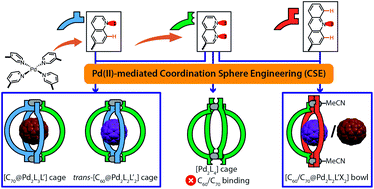
Chem. Sci., 2022,13, 1829-1834
https://doi.org/10.1039/D1SC06931D
Enhanced N-directed electrophilic C–H borylation generates BN–[5]- and [6]helicenes with improved photophysical properties
An enhanced N-directed electrophilic C–H borylation methodology has been developed that provides access to azaborine containing helicenes.
![Graphical abstract: Enhanced N-directed electrophilic C–H borylation generates BN–[5]- and [6]helicenes with improved photophysical properties](/en/Image/Get?imageInfo.ImageType=GA&imageInfo.ImageIdentifier.ManuscriptID=D1SC06513K&imageInfo.ImageIdentifier.Year=2022)
Chem. Sci., 2022,13, 1136-1145
https://doi.org/10.1039/D1SC06513K
About this collection
This specially curated collection pulls together some of the most popular articles from 2022 in the field of supramolecular chemistry. The collection presents some outstanding contributions to the field, ranging from the synthesis of catenane assemblies to chiral molecular nanosilicas, and as with all Chemical Science articles – they are all completely free to access and read. We hope you enjoy browsing through this collection.
If a particular article has inspired you, do feel free to share on social media using the buttons on each article landing page and use our hashtag: #ChemSciMostPopular